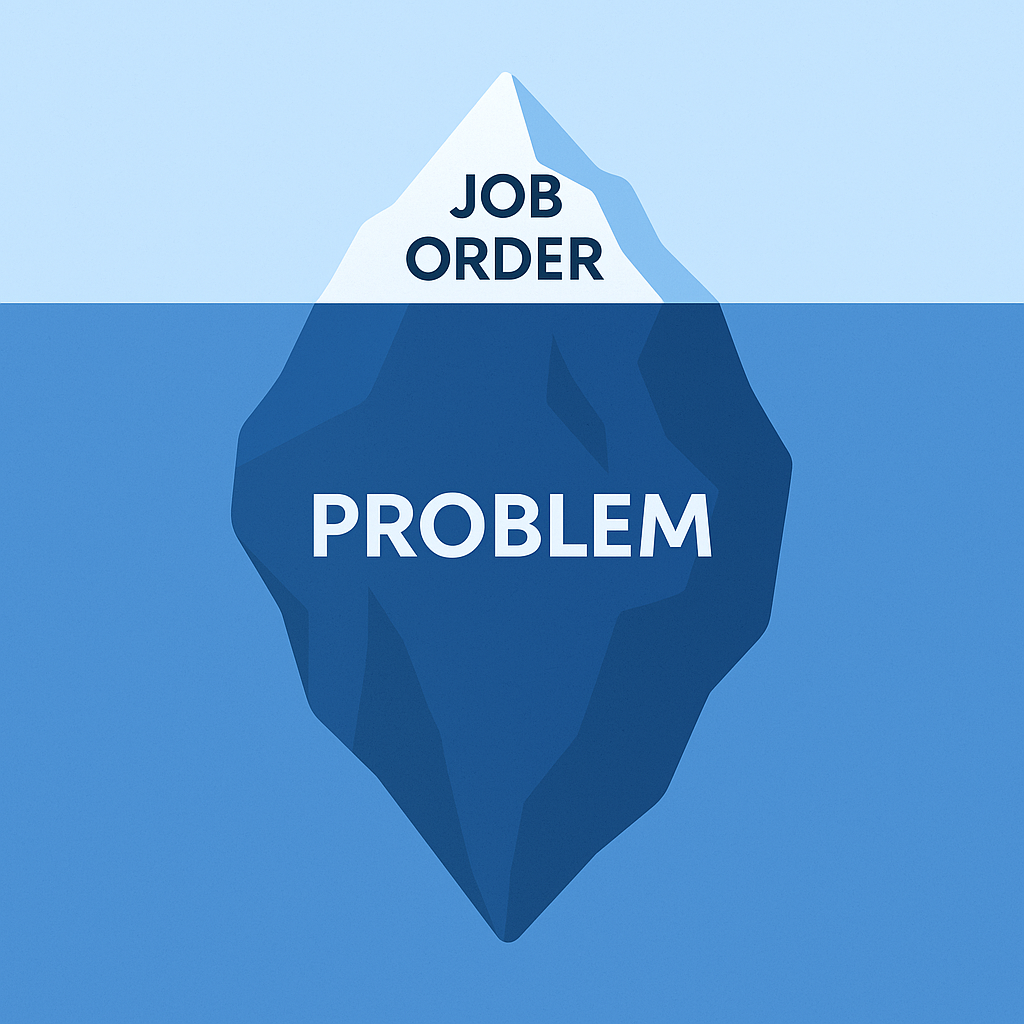Selling With Your Consultant
In my previous post, How to Prevent Unexpected Contract Terminations, I shared how systemizing consultant and client check-ins at key milestones...
6 min read
![]() Dan Fisher
:
Mar 28, 2025 8:05:05 AM
Dan Fisher
:
Mar 28, 2025 8:05:05 AM

Recruiting in 2025 isn’t about finding talent—it’s about moving talent. In a risk-averse market, even unhappy candidates won’t make a move unless they feel emotionally and financially safe, and understood.
Despite this, most recruiters are still pitching jobs to passive candidates who don’t yet believe they need a new job or are not yet ready emotionally to make a move. These recruiters are skipping the real work, psychological self-discovery, required to help the candidate want to make a career change.
In this issue you will learn:
The Current Tech Hiring Climate
Tech hiring seems to be a bit of a paradox. On one hand, companies like Meta and Microsoft have announced layoffs, citing economic uncertainty. HP, Stripe, EA and others have also announced layoffs. On the other hand, the market for specialized tech roles remains as competitive as ever. Demand for data, cloud and software engineers remains high while unemployment rates hover at just 2.2% for software developers and 1.6% for IT support specialists.
It’s clear that while overall hiring has slowed, the demand for top-tier talent hasn’t disappeared. While layoffs suggest a slowdown in hiring, tightening of budgets, and a focus on cost reduction, they do not indicate a diminished need for specialized tech talent. Instead, companies are prioritizing high-impact roles—positions that directly contribute to revenue, innovation, and operational resilience.
This is nothing new.
But here’s what is.
The current economic uncertainty is impacting the psyche of today’s passive candidates. Their risk tolerance is at an all-time low, making them highly cautious about change and reluctant to pursue new opportunities—even if their current situation is less than ideal. Most see staying put as the safer bet.
Better the devil you know than the devil you don't.
The biggest mistake you can make in today’s market is assuming that passive candidates are open to hearing about your opportunity simply because the opportunity exists. Even if your new role offers better pay, a bigger title, or exciting work, those factors alone won’t be enough to pull them away from what feels safe and familiar.
Why? Because today’s passive candidates aren’t just evaluating your job opportunity—they're weighing the risk of leaving their current one. And until they believe it’s time to go, they won’t be ready to consider something new.
To successfully engage today’s risk-averse candidate, you must shift your approach from pitching an opportunity to guiding your candidates through a process of self-discovery.
And this self-discovery process is emotional. It’s psychological.
Current State and Desired Future State
Every candidate you contact is at a point that I like to refer to as their current state. In their current state, the candidate is experiencing admitted pain or latent pain. Admitted pain means the candidate is facing a problem, obstacle, “pain point,” or dissatisfaction with their current job, employer, or supervisor. It could be compensation, benefits, work/life balance, micromanagement, etc. Your candidate is consciously aware of the issue(s).
Latent pain refers to a problem or challenge that your candidate is experiencing—but hasn’t yet recognized, contextualized or articulated, as something that needs to be solved. It's "under the surface," meaning the candidate may be feeling symptoms but hasn’t connected the dots to the root cause, or they’ve simply adapted to the issue and don’t see it as urgent (yet). Or, there could be an opportunity that they have not yet recognized or taken advantage of.
Consider this post from Reno Perry.
 Even “happy” candidates who respond to your outreach with “not interested” face these issues with their current employers. Whether or not they are consciously aware of this is another story.
Even “happy” candidates who respond to your outreach with “not interested” face these issues with their current employers. Whether or not they are consciously aware of this is another story.
When speaking with candidates, what you are looking for is a disparity. The disparity you are looking for is the “gap” between where the candidate is today (their current state) and where they would like to be, or their desired future state.
Desired future state refers to the ideal outcome your candidate wants to achieve—what “great” looks like for them.
This is critically important because it is a lot easier to position your opportunity and the employer you represent when it is positioned in a way that will help your candidate achieve their career goals.
Your New Job Description
Your job is to help your candidate bridge the gap between where they are and where they want to be. Your new job description is to de-risk career decisions on behalf of your candidates.
In my experience, only the top 10% of recruiters know how to do this.
Until your passive candidate comes to their own self-realization (admits) that they are dissatisfied in their current role (or have a vision for their desired future state)—and believes that the benefits of accepting a new opportunity outweigh the 'pain' of staying put—you won’t be able to place them.
This is no easy task because many candidates have convinced themselves that their current role is “good enough,” even if they feel stuck, undervalued, or underpaid.
Your new job description requires you to ask your candidates thought-provoking questions that prompt them to reflect on how happy and content they are with their current role and employer including their career path, upward mobility, learning and development opportunities, compensation and benefits, and how they feel about their supervisor and senior leadership.
This is why great recruiters don’t pitch their job—they ask the right questions to help their candidates evaluate whether they are truly happy and content with where they are.
Instead of asking, "Are you open to a new opportunity?" shift to questions like:
Listen for moments of hesitation or uncertainty—that’s often where the real ‘pain’ resides.
How to Guide Your Candidates Towards Change
When candidates start voicing concerns, they are beginning to acknowledge potential misalignment between their current job (current state) and their career aspirations (desired future state). This is your que to guide them toward considering change.
You guide them by leading with questions, not pitching a job.
Your job is to ask thought-provoking questions that help your candidates come to their own self-realization of the issues, roadblocks and fears that are holding them back and preventing them from achieving their career goals (arriving at their desired future state).
Pitching a job is easy.
It takes a highly skilled recruiter to come along and inform them that there is a better place to be before they can envision it.
Helping a candidate think about and vividly imagine what their world might be like if they were to arrive at their desired future state (achieve their next career goal) is how you move from transactional recruiter to career consultant.
In my recruiter training I like to ask recruiters, “can your candidates tell whether you are focused more on the job you are pitching, or on helping them achieve their career goals?”
Everyone seems to agree that candidates can easily tell which they are focused on.
How is it possible they can tell?
The answer is, “By the things you say and do and especially by the questions you ask.”
When you lead with questions you not only uncover root-cause issues, but you challenge assumptions and force your candidates to think about and uncover new ideas and possibilities that they would not have considered otherwise. More importantly, candidates like the feeling they get when they discover answers on their own. When you empower your candidates to come up with their own ideas or solutions, they own it. When they own it, they are far more likely to take action and apply it.
This is how you get highly skeptical, passive candidates to consider change.
This is how you guide them and help them achieve their career goals.
For you, the goal is to create a dialogue where your candidate feels self-motivated and self-empowered to grow, excel, and take greater responsibility for their career including their own actions and results.
But you must shift your mindset from pitching jobs to leading your candidates with questions
The Bottom Line
Recruiting in today’s market requires a shift in your mental model. It’s not about pitching jobs—it’s about helping your candidates recognize that they deserve something better. Before you can convince your candidate to consider your job opportunity, you must first help them realize why it’s time to leave their current one. And that starts by engaging them in a way that resonates emotionally, not just professionally.
Because in 2025, making placements isn’t pitching jobs,—it’s about de-risking career decisions in an era of uncertainty.

In my previous post, How to Prevent Unexpected Contract Terminations, I shared how systemizing consultant and client check-ins at key milestones...

About a year ago, I was serving as the fractional revenue leader, managing sales and recruiting for a client.

If you’ve worked in staffing long enough, you’ve been trained to chase job orders.